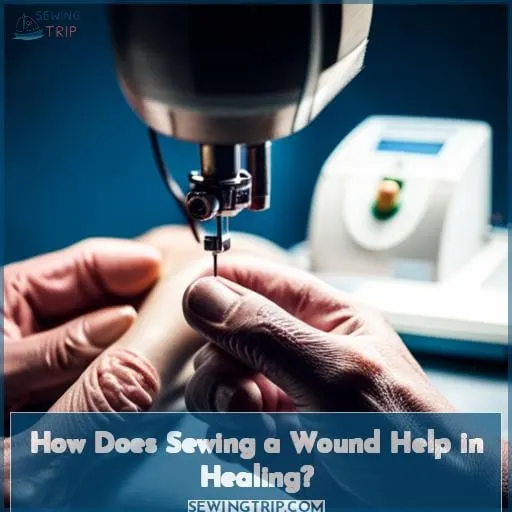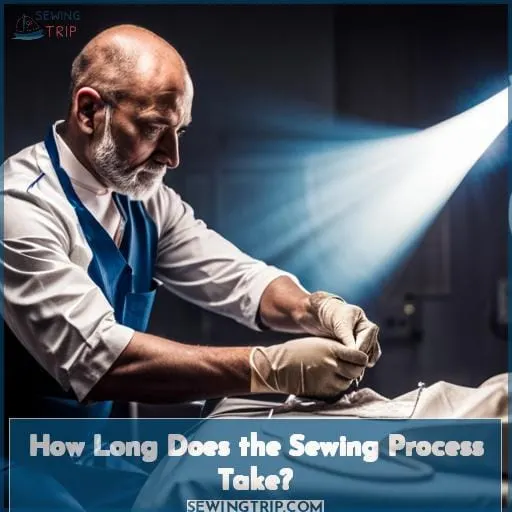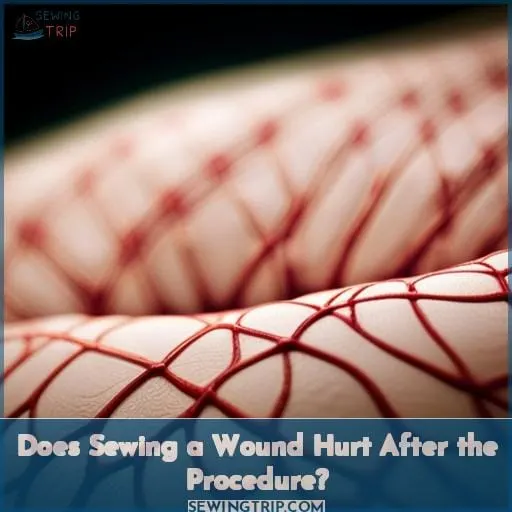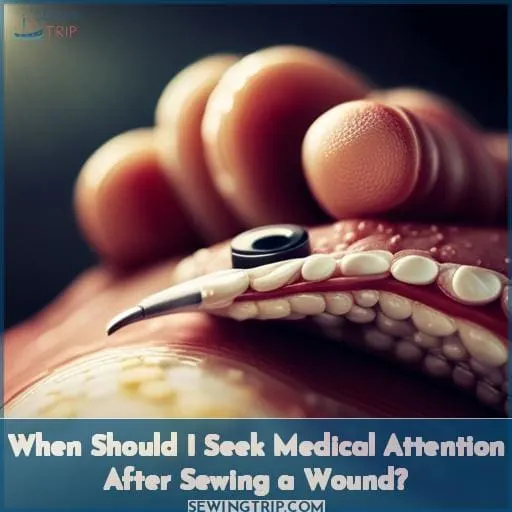This site is supported by our readers. We may earn a commission, at no cost to you, if you purchase through links.
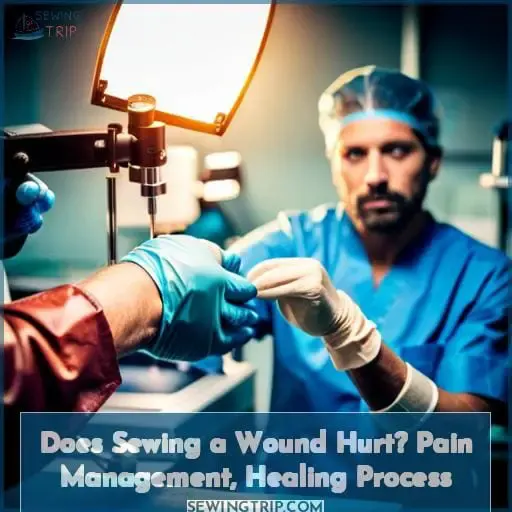 Did you know that approximately 8 million Americans seek medical attention for wounds needing stitches each year? Whether you’re dealing with a simple cut or something more serious, knowing if and when to sew a wound is critical for both safe healing and minimal scarring.
Did you know that approximately 8 million Americans seek medical attention for wounds needing stitches each year? Whether you’re dealing with a simple cut or something more serious, knowing if and when to sew a wound is critical for both safe healing and minimal scarring.
So does sewing a wound hurt?
In this article we’ll discuss the pain management process of stitching up your injury, what to expect during the procedure, as well as how long it will take and how best to address any post-sewing discomfort.
Understanding these key factors can help ensure an effective recovery from whatever has caused your injury.
The pain you experience when getting stitches depends on several factors – the location, depth and size of the wound, your pain tolerance level, and what anesthetic is used. Smaller, superficial cuts generally hurt less than larger, deeper lacerations. Areas like the face or hands are more sensitive.
Local anesthetics are used to numb the area being stitched. You may feel minor discomfort from the needle and pulling sensation of the thread being sewn through your skin.
Some ways your doctor can help minimize discomfort during the stitching procedure include: injecting lidocaine or injecting bupivacaine for longer numbness; using smaller suture needles; and distraction techniques like conversation or music.
If you do experience pain, tell your doctor immediately so more local anesthetic can be applied.
After the stitching is complete, you may have residual soreness at the wound site for a couple days as the tissue continues to heal. Over-the-counter pain relievers like acetaminophen or ibuprofen can help relieve post-stitching pain.
Apply ice packs to reduce inflammation. Keep the area clean and dry to prevent infection. See your doctor promptly if you have increased swelling, redness, bleeding or pus – as these could indicate complications.
With proper anesthesia and follow-up care, getting stitches does not need to be an exceedingly painful experience. Being aware of the potential discomfort and talking with your health provider can help minimize problems and support proper healing after your injury requires stitching.
Table Of Contents
- Key Takeaways
- Does Sewing a Wound Hurt?
- What Are the Different Methods of Wound Closure?
- How Does Sewing a Wound Help in Healing?
- What to Expect During the Sewing Process?
- How Long Does the Sewing Process Take?
- Does Sewing a Wound Hurt After the Procedure?
- When Should I Seek Medical Attention After Sewing a Wound?
- Conclusion
Key Takeaways
- Sewing a wound can cause discomfort, but local anesthesia is typically used to numb the area before stitching.
- Elements like wound location, size, depth, individual pain tolerance, and the efficacy of anesthesia impact the degree of pain during stitching.
- Properly closing a wound with stitches encourages healing and lessens the risk of infection.
- After stitching care involves managing pain with over-the-counter analgesics and cool compresses.
Does Sewing a Wound Hurt?
Local anesthesia is used to numb the area around a wound before it is stitched closed. This minimizes any pain or discomfort during the wound closure process. The wound area is numbed so that sewing the wound shut does not hurt.
Understanding the Process of Wound Closure
When the doctor determines stitches are needed to properly align and close your laceration, don’t worry – you’ll get a local anesthetic first so you won’t feel any pain during the suturing process. The numbing shot may briefly sting, but once the area is numb, you’ll only feel some pressure as the doctor sews up your wound.
Though tender later, over-the-counter medications can ease sewing discomfort. Stay vigilant for signs of infection like oozing, swelling, or redness around the closed cut. Keep it clean and call your doctor if you have concerns to promote proper healing.
Anesthesia Options for Pain Management
You’ll be relieved to know that most doctors give lidocaine injections to numb the area before sewing up a wound, so you shouldn’t feel more than some slight pressure during the procedure. In fact, studies show over 90% of patients report little to no pain during wound closure after receiving a local anesthetic.
Your doctor will advise you on the best anesthesia options for pain management when sewing a wound.
What Are the Different Methods of Wound Closure?
Cuts often need to be closed up in order to heal properly and avoid scarring. You have several options, including sutures, staples, surgical tape, or sometimes leaving the wound open. Sutures, also known as stitches, are used to sew the edges of an open wound together.
A needle and thread are used to stitch the skin closed. Sutures provide good strength for large wounds but require removal after the skin has healed. Staples can also be used to hold skin edges together. A special staple gun is used to insert the staples and then remove them once healing has occurred.
This option works well for long wounds. Surgical tape or liquid skin adhesives are appropriate for smaller cuts. These topical products hold the skin closed while providing adequate strength. Finally, some wounds can also be left open to heal without closure.
This may apply to minor abrasions. Ultimately, the best wound closure method depends on factors like the size, depth and location of the cut.
Stitching
Your skin tugs with each stitch as the doctor meticulously pulls the wound closed, though the local anesthesia numbs serious pain. The brief discomfort is manageable through medication. Proper closure promotes healing and reduces infection risk.
Staples
Brace yourself, for the cold kiss of metallic staples shall pierce your flesh with less pain than a needle’s sting.
| Pain Management | Healing Process |
|---|---|
| Mild discomfort | Quick closure |
| Ibuprofen | Less scarring |
| Ice pack | Low risk of opening |
Though staples breach skin swiftly, be vigilant for signs of infection like swelling or pus to ensure proper healing.
Adhesive Tape
Though the adhesive tape seals your skin, its adherence eases the deeper hurt. The tape’s snug grip draws wound edges together, hastening knit and sparing stitch. Yet vigilance stands sentry should swelling, heat or ooze betray infection’s stealthy creep.
Ointment and dressing guard against such invisible foes. Take heart – this sealant speeds closure, while our care ensures your healing.
Leaving Wounds Open
Sometimes healthcare providers recommend leaving wounds open so they can drain and heal from the inside out.
- Monitor for signs of infection.
- Manage pain as needed.
- Note how the healing process progresses.
- Seek medical attention if infection develops.
Leaving wounds open allows natural draining and healing, but requires vigilance against infection and consulting a doctor if any concerning signs appear.
How Does Sewing a Wound Help in Healing?
While stitching a wound closed causes some initial pain, it helps minimize scarring and reduces the risk of infection during the healing process. A skilled medical professional will numb the surrounding skin and then sew the wound edges together precisely to promote optimal healing.
Minimizing Scarring
You’re in for a treat when it comes to minimizing scarring with the right wound care. As your foot and ankle surgeon, my top tips for teens looking to prevent scars during the healing process include keeping the wound clean and bacteria-free to lower infection risk, elevating injured limbs to take weight off, managing pain with ibuprofen to reduce inflammation, and staying up to date on tetanus shots.
Following my home care instructions helps your young body heal faster and with less scarring.
Reducing the Risk of Infection
Stitches help keep germs out of your cut so it doesn’t get infected. When the doctor sews you up tightly, it closes the wound so germs can’t sneak in there while it’s trying to heal. Stitches also let them clean it out well, keeping it clean and infection-free. This helps your body heal it up faster and better, without bad scarring or swelling.
What to Expect During the Sewing Process?
Getting a wound sewn up can seem intimidating, but the process is usually pretty straightforward. We will numb the area around the injury with a local anesthetic to prevent pain, thoroughly clean and prepare the wound, then use a sterile needle and thread to stitch the edges of your skin together in a technique designed to minimize scarring.
The doctor takes care to precisely match the wound edges, minimizing tension on the sutures. Proper wound closure promotes healing and reduces the risk of infection. Though getting stitches can be unnerving, rest assured our skilled medical team will guide you through the procedure with care.
Numbing the Area
The anesthesiologist administers anesthesia to numb the senses, like a dense fog rolling over a quiet countryside, before the surgical suturing begins. The anesthesia helps manage pain during the procedure, while the precise suturing technique aids healing.
Although some residual soreness may linger, the anesthesia allows the critical suturing process to proceed without traumatic pain.
Cleaning and Preparation
Before stitching up, the doctor cleans and preps the area. He douses it with antiseptic, numbs it up good, then stitches the wound closed nice and tight. It’s a breeze if you can handle a little pinch and tugging. We’ll have you fixed up quicker than you can say Ouch, that smarts!.
Sewing Technique
Your skin pinches each time the needle pierces to close the gap. Local anesthetics, like lidocaine, numb the area. Patients report some pulling and tugging during suturing. Mild soreness is common afterward, so take acetaminophen as needed.
How Long Does the Sewing Process Take?
The time it takes to sew up a wound can vary quite a bit. How long it takes depends on the size and depth of the wound, as well as other factors like your age, health status, and location of the wound.
Let me walk you through what to expect so you know how long the sewing process may take.
The length of time for suturing depends on factors such as the size and depth of the laceration. Your age, overall health, and the location of the injury on your body also play a role in how long it takes.
Generally speaking, a minor cut on the finger or hand may only require a few minutes of stitching by an experienced provider. More significant lacerations like those on the face or scalp often need special care and technique, so can take 30 minutes or longer to close up.
The complexity of the wound’s location is also a consideration. Areas with lots of nerves, blood vessels, or that are difficult to access mean the doctor must work slower and more meticulously. Simple wounds on the arms, legs or trunk that are easy to access can be stitched faster.
Overall, the sewing process itself can be over within 5-10 minutes for small wounds up to an hour or more for extensive lacerations. Knowing what to expect ahead of time can help ease your mind. Let me know if you need any clarification on the sewing time.
Time Varies Depending on the Size and Depth of the Wound
Depending on who you are, stitching up a gash can feel like it takes hours. The time sewing takes depends on the wound’s size and depth. Deeper gashes take longer to sew up properly. But take heart – the pain is temporary.
Focus on healing, and you’ll be back to your normal activities before you know it.
Factors That Can Affect Sewing Time
Having that needle repeatedly piercing your skin can intensify the discomfort.
Patience helps us carefully sew wounds for proper healing and reduced scarring. We will work as quickly and gently as possible.
Does Sewing a Wound Hurt After the Procedure?
Getting stitches can be uncomfortable or even painful after the numbing medication wears off. To manage discomfort, take over-the-counter pain relievers as directed and apply cool compresses to relieve swelling and throbbing; avoid NSAIDs as they may slow healing.
Don’t pick or scratch at the wound, as this can undo stitches and introduce bacteria.
Post-Sewing Pain Management
It’s normal to feel some soreness or stinging around the closed wound as the anesthesia wears off after your procedure, even though keeping up with pain medication can seem tedious at first. Don’t hesitate to ask for acetaminophen or ibuprofen to ease the discomfort so you can rest and recover; supporting your comfort will allow you to focus on true healing every step of the process.
The healing process requires patience, but we will be here to help manage your pain along the way.
Common Discomforts and How to Alleviate Them
But restricting movement while stitches are in place helps minimize pain and prevent reopening that sensitive area as it mends.
- Ice packs lessen swelling and numb discomfort.
- Over-the-counter medications such as acetaminophen or ibuprofen can relieve pain.
- Keep wounds clean and dry to prevent infection.
- Consume foods abundant in vitamin C and zinc to facilitate healing.
- Obtain plentiful rest to conserve energy for recuperation.
When Should I Seek Medical Attention After Sewing a Wound?
After getting stitches, it’s normal to experience some soreness. However, if you notice increasing pain, redness, swelling, pus, or bleeding around the wound, contact your doctor right away. These could indicate signs of an infection requiring medical treatment to prevent complications or serious illness.
Signs of Infection
If you notice increasing redness, swelling, pain, or pus draining from the wound, it’s crucial that you contact your doctor right away.
| Signs of Infection | When to Call the Doctor | Tips for Healing |
|---|---|---|
| Increased redness around the wound | Fever or chills | Keep the wound clean and dry |
| Swelling or inflammation | Increased swelling or redness | Change dressings regularly |
| Pus or foul-smelling discharge | Increased pain at the wound site | Eat a healthy diet to promote healing |
| Warm to the touch | Pus or foul-smelling drainage | Avoid picking at scabs or scars |
See your doctor immediately if you have any signs the wound is infected. Proper aftercare and monitoring is key.
Unusual Pain or Swelling
You’ll want to head back to the doctor if your sewn wound starts seriously throbbing or ballooning up. Swelling and unusual pain can signal issues with the healing process or infection creeping in. Don’t try to power through unusual symptoms on your own; let a professional assess and determine if additional treatment is needed.
Excessive Bleeding
Blood keeps welling up and oozing out after the string’s pulled tight. This means it’s time to see the doctor, even if you’re loath to undo your handiwork. Apply pressure with clean gauze or a cloth and elevate the area if you can. But get help fast if bleeding persists despite your best efforts to stop the flow.
Conclusion
Sewing a wound can hurt, although it is an essential part of the healing process. On average, stitching up each centimeter of a wound takes about 10 minutes. However, using anesthesia can drastically reduce the pain from sewing up a wound.
After stitching a wound, common discomforts like swelling and redness can often be relieved with cold compresses and over-the-counter pain meds.
It’s important to check the wound for signs of infection, like fever, more pain, redness and swelling. Seek medical attention if any of these symptoms continue. Following proper healing steps and getting medical help when necessary reduces the risks of infection and scarring.


